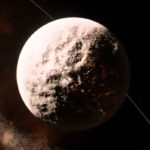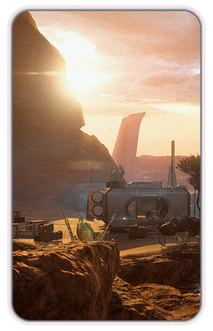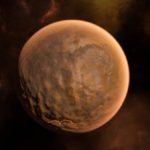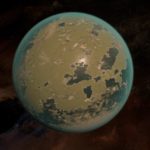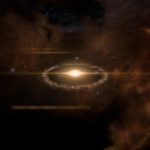System Specs:
- Stellar Mass: _ Sol-masses
- Stellar Class: _
- Luminosity: _ Sol
- Planets: 6
- Moons: 0
- Asteroid Belts: 1
- Asteroids: 1
- Objects: 3
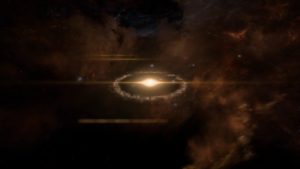
The system is named after the ancient Greek explorer Pytheas of Massalia who explored Europe in antiquity.
Asteroid
DATA:
- M-type asteroid
- Diameter: 420 km
- Surface gravity: 0.034 G
ANALYSIS:
An iron-nickel rich asteroid. Its dust indicates the same Scourge contamination that affects Eos.
–
Planets Directory:
- H-060
- Eos
- Pele
- H-276
- Nanuk
- Khonsu
–
H-060:

- Orbital Distance: 0.6 AU
- Orbital Period: 11 Earth-years
- Keplerian Ratio: 0.002
- Radius: 7,968 km
- Day Length: _ Earth-hours
- Atmospheric Pressure: 23.65 atm
- Surface Temp: 198 °C
- Surface Gravity: _ g
- Mass: _ Earth-masses
H-060 and its satellites attract debris from Pytheas‘ asteroid belt, resulting in multiple dust rings. Numerous meteorite impacts have left H-060 rich in nickel, but these same impacts make mining difficult.
–
Eos:

- Orbital Distance: 1.3 AU
- Orbital Period: 1.6 Earth-years
- Keplerian Ratio: 0.858
- Radius: 2,952 km
- Day Length: _ Earth-hours
- Atmospheric Pressure: 1.98 atm
- Surface Temp: 19 °C
- Surface Gravity: _ g
- Mass: _ Earth-masses
- Satellites: 1
- Colony: Prodromos (capital, founded 2819, of species: humans and the others of the Andromeda Initiative)
Nonviable
A desert world with significant resources, Eos is often wracked by deadly, radiation-contaminated storms. Catalogued as nonviable after numerous attempts to settle.
ALERT: Signal detected, similar to the devices on Habitat 07.
Viable
A desert world with significant resources, Eos is home to the first successful Andromeda Initiative outpost, Prodromos. (Founded by Pathfinder Ryder, Mayor August Bradley assigned.)
Codex Entry
Initial Entry
Eos, designated Habitat 1, was the earliest “golden world” identified for outpost placement. Named for the Greek goddess of dawn by Jien Garson personally, Eos embodied the hope of the Andromeda Initiative for a new start.
On arrival, the Nexus discovered that a world projected to be arid but comfortably habitable was now ravaged by radioactive fallout from the Scourge. The planet’s atmosphere is wracked by storms that have spread the radiation across continents; periodic 130 KPH winds strip equipment and damage shuttles.
Reports from the Nexus include a sanitized account of two attempts to colonize the planet, both of which ended in failure and an unacceptable loss of life. There is also a significant kett presence on Eos, apparently investigating mysterious signals on the surface. Eos is now off-limits to unauthorized Nexus personnel, as the Nexus leadership believe it’s no longer viable.
Eos Vault Activated
Activating the vault discovered below Eos’ surface has had a dramatic and immediate effect. Radioactive particles are being stripped from the atmosphere by unknown means, and the resulting temperature changes are calming Eos’ high winds. The planets moisture levels are already showing improvement.
Eos Outpost Established
Prodromos, the first Pathfinder-established outpost, has been founded in Fairwinds Basin, with Mayor August Bradley in charge. The Nexus is broadcasting footage of departing colonists and the new conditions on Eos across all communication channels.
–
Pele:
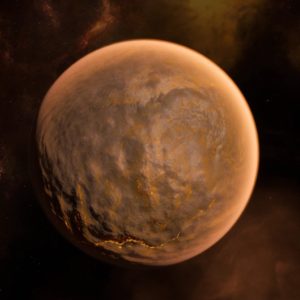
- Orbital Distance: 12.1 AU
- Orbital Period: 47.2 Earth-years
- Keplerian Ratio: 0.795
- Radius: 7,091 km
- Day Length: _ Earth-hours
- Atmospheric Pressure: 7.01 atm
- Surface Temp: 781 °C
- Surface Gravity: _ g
- Mass: _ Earth-masses
Tidal heating and bombardment from Pytheas‘ asteroid belt has aggravated Pele’s volcanic activity. Methane in its upper atmosphere contributes to the planet’s scorching conditions.
–
H-276:
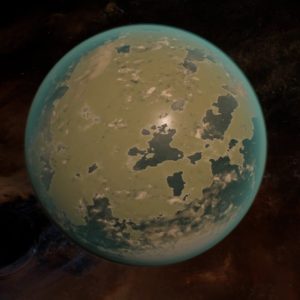
- Orbital Distance: 27.8 AU
- Orbital Period: 164.6 Earth-years
- Keplerian Ratio: 0.793
- Radius: 7,185 km
- Day Length: _ Earth-hours
- Atmospheric Pressure: 11.13 atm
- Surface Temp: -77 °C
- Surface Gravity: _ g
- Mass: _ Earth-masses
- Satellites: 1
Remote and cold, H-276 is nevertheless of interest due to phosgene gas in its thick chlorine atmosphere. This could indicate primitive chlorine-based life. However, no detailed study has been completed.
Satellite
DATA:
Satellite ID: Nexus 0900-G
Power readings: 84%
System report: Databanks prepped for download
Status: Operational
ANALYSIS:
A scientific monitoring satellite launched by early explorers to Eos. Its mission was abandoned when the original settlement of Eos failed, but it has gathered valuable data from H-276.
–
Nanuk:
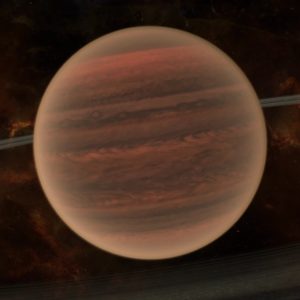
- Orbital Distance: 27.9 AU
- Orbital Period: 164.9 Earth-years
- Keplerian Ratio: 0.799
- Radius: 25,194 km
- Day Length: _ Earth-hours
- Atmospheric Pressure: 1.54 atm
- Surface Temp: _ °C
- Surface Gravity: _ g
- Mass: _ Earth-masses
- Satellites: 1
Khonsu:

- Orbital Distance: 31.4 AU
- Orbital Period: 197 Earth-years
- Keplerian Ratio: 0.798
- Radius: 7,495 km
- Day Length: _ Earth-hours
- Atmospheric Pressure: 3.57 atm
- Surface Temp: -178 °C
- Surface Gravity: _ g
- Mass: _ Earth-masses
Khonsu’s oddly mild climate – given its orbital distance – and rich resources made it a candidate for a mining outpost. However, its unexpectedly rugged terrain has tabled discussions indefinitely.
Beryllium
DATA:
Beryllium
ANALYSIS:
A metal ideal for lightweight construction in a variety of applications. This deposit is readily accessible.
–
